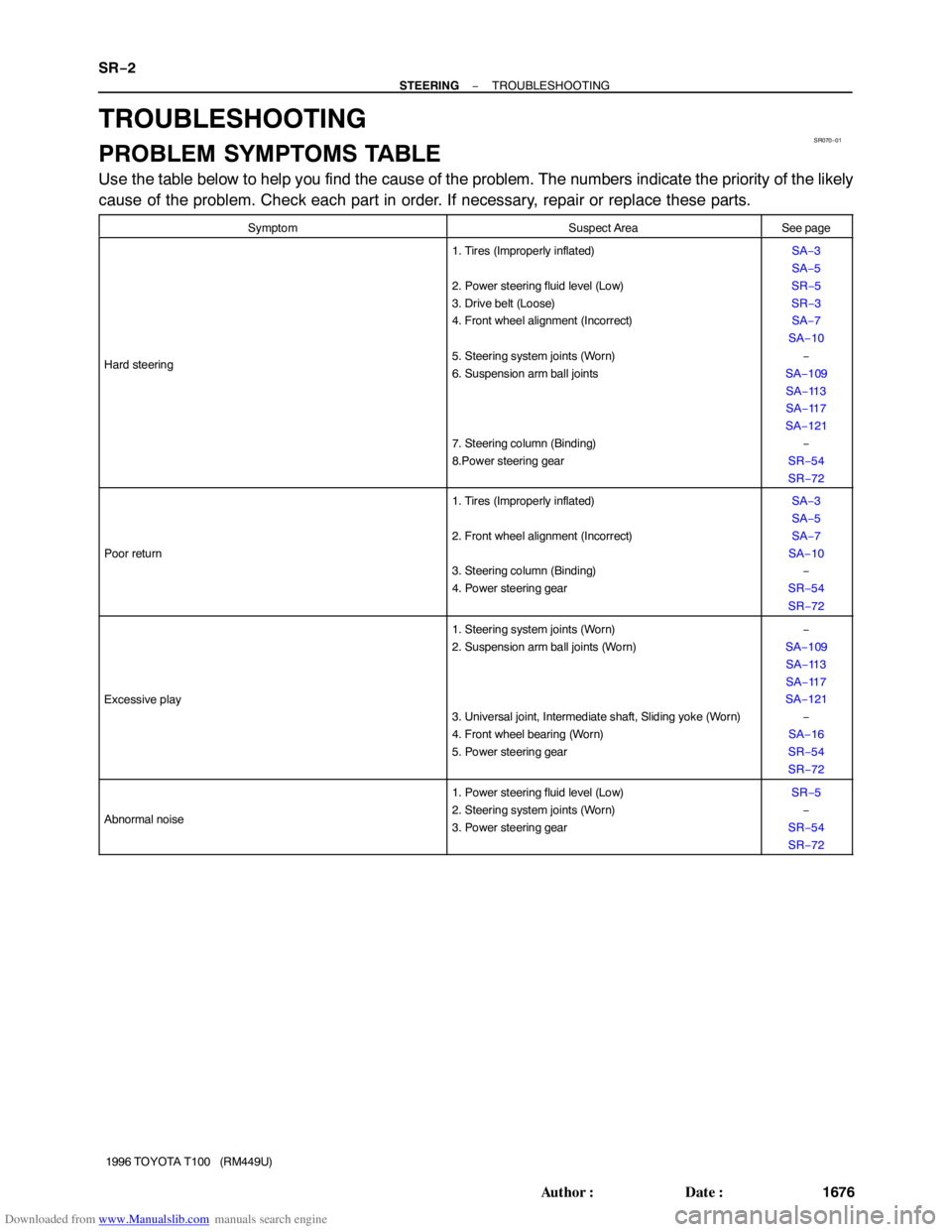Page 34 of 2062

Downloaded from www.Manualslib.com manuals search engine IN02L−01
− INTRODUCTIONTERMS
IN−31
31 Author�: Date�:
1996 TOYOTA T100 (RM449U)
TERMS
ABBREVIATIONS USED IN THIS MANUAL
AbbreviationsMeaning
ABSAnti−Lock Brake System
A.D.D.Automatic Disconnecting Differential
A/TAutomatic Transmission
AT FAutomatic Transmission Fluid
BTDCBefore Top Dead Center
Calif.California
CBCircuit Breaker
Diff.LockDifferential Locking System
DPDash Pot
ECUElectronic Control Unit
E/GEngine
ELREmergency Locking Retractor
ESAElectronic Spark Advance
EXExhaust (Manifold, Valve)
FIPGFormed in Place Gasket
FLFusible Link
FPUFuel Pressure Up
FrFront
IGIgnition
INIntake (Manifold, Valve)
J/BJunction Block
LHLeft−Hand
LLCLong Life Coolant (Year Around Coolant)
LSPVLoad Sensing Proportioning Valve
Max.Maximum
Min.Minimum
MPMultipurpose
M/TManual Transmission
O/D, ODOverdrive
OHCOver Head Camshaft
O/SOversize
PCVPositive Crankcase Ventilation
PSPower Steering
RHRight−Hand
RrRear
SRSSupplemental Restraint System
SSMSpecial Service Materials
SSTSpecial Service Tools
STDStandard
SWSwitch
TDCTop Dead Center
TEMP.Temperature
Page 43 of 2062

Downloaded from www.Manualslib.com manuals search engine MA003−05
MA−4
− MAINTENANCEUNDER HOOD
39 Author�: Date�:
1996 TOYOTA T100 (RM449U)
UNDER HOOD
GENERAL MAINTENANCE
1. GENERAL NOTES
�Maintenance items may vary from country to country. Check the owner’s manual supplement in which
the maintenance schedule is shown.
�Every service item in the periodic maintenance schedule must be performed.
�Periodic maintenance service must be performed according to whichever interval in the periodic main-
tenance schedule occurs first, the odometer reading (miles) or the time interval (months).
�Maintenance service after the last period should be performed at the same interval as before unless
otherwise noted.
�Failure to do even one item can cause the engine to run poorly and increase exhaust emissions.
2. WINDSHIELD WASHER FLUID
Check that there is sufficient fluid in the tank.
3. ENGINE COOLANT LEVEL
Check that the coolant level is between the FULL and LOW lines on the see−through reservoir.
4. RADIATOR AND HOSES
(a) Check that the front of the radiator is clean and not blocked with leaves, dirt or bugs.
(b) Check the hoses for cracks, kinks, rot or loose connections.
5. BATTERY ELECTROLYTE LEVEL
Check that the electrolyte level of all battery cells is between the upper and lower level lines on the case.
6. BRAKE AND CLUTCH FLUID LEVELS
Check that the brake and clutch fluid levels are near the upper level line on the see−through reservoirs.
7. ENGINE DRIVE BELTS
Check all drive belts for fraying, cracks, wear or oiliness.
8. ENGINE OIL LEVEL
Check the level on the dipstick with the engine turned off.
9. POWER STEERING FLUID LEVEL
(a) Check the level on the dipstick.
(b) The level should be in the HOT or COLD range depending on the fluid temperature.
10. AUTOMATIC TRANSMISSION FLUID LEVEL
(a) Park the vehicle on a level surface.
(b) With the engine idling and the parking brake applied, shift the selector into all positions from the P to
L, and then shift into the P position.
(c) Pull out the dipstick and wipe off the fluid with a clean rag. Re−insert the dipstick and check that the
fluid level is in the HOT range.
(d) Do this check with the fluid at normal driving temperature (70 − 80°C, 158 − 176°F).
HINT:
Wait until the engine cools down (approx. 30 min.) before checking the fluid level after extended driving at
high speeds, in hot weather, in heavy traffic or pulling a trailer.
11. EXHAUST SYSTEM
(a) Visually inspect for cracks, holes or loose supports.
(b) If any change in the sound of the exhaust or smell of the exhaust fumes is noticed, have the cause
located and corrected.
Page 155 of 2062
Downloaded from www.Manualslib.com manuals search engine PP0FD−01
− PREPARATIONBRAKE
PP−101
1996 TOYOTA T100 (RM449U)
LUBRICANT
ItemCapacityClassification
Brake fluid−SAE J1703 or FMVSS No.116 DOT 3
Power steering fluid−ATF DEXRON® II
Page 165 of 2062
Downloaded from www.Manualslib.com manuals search engine PP0FX−01
− PREPARATIONSTEERING
PP−111
1996 TOYOTA T100 (RM449U)
LUBRICANT
ItemCapacityClassification
Power steering fluid
Total0.8 liters (0.85 US qts, 0.70 Imp.qts)ATF DEXRON®II or III
Page 1707 of 2062
Downloaded from www.Manualslib.com manuals search engine SR – STEERING
STEERING SYSTEM SR-1
TROUBLESHOOTING SR-2
DRIVE BELT SR-3
POWER STEERING FLUID SR-4
AIR CONTROL VALVE SR-8
STEERING WHEEL SR-9
NON-TILT STEERING COLUMN SR-10
TILT STEERING COLUMN SR-23
POWER STEERING VANE PUMP (3RZ-FE) SR-34
POWER STEERING VANE PUMP (5VZ-FE) SR-44
POWER STEERING GEAR (2WD) SR-54
POWER STEERING GEAR (2WD) SR-72
STEERING LINKAGE SR-84
IDLER ARM SR-89
Page 1709 of 2062

Downloaded from www.Manualslib.com manuals search engine SR070−01
SR−2
− STEERINGTROUBLESHOOTING
1676 Author�: Date�:
1996 TOYOTA T100 (RM449U)
TROUBLESHOOTING
PROBLEM SYMPTOMS TABLE
Use the table below to help you find the cause of the problem. The numbers indicate the priority of the likely
cause of the problem. Check each part in order. If necessary, repair or replace these parts.
SymptomSuspect AreaSee page
Hard steering
1. Tires (Improperly inflated)
2. Power steering fluid level (Low)
3. Drive belt (Loose)
4. Front wheel alignment (Incorrect)
5. Steering system joints (Worn)
6. Suspension arm ball joints
7. Steering column (Binding)
8.Power steering gearSA−3
SA−5
SR−5
SR−3
SA−7
SA−10
−
SA−109
SA−11 3
SA−11 7
SA−121
−
SR−54
SR−72
Poor return
1. Tires (Improperly inflated)
2. Front wheel alignment (Incorrect)
3. Steering column (Binding)
4. Power steering gearSA−3
SA−5
SA−7
SA−10
−
SR−54
SR−72
Excessive play
1. Steering system joints (Worn)
2. Suspension arm ball joints (Worn)
3. Universal joint, Intermediate shaft, Sliding yoke (Worn)
4. Front wheel bearing (Worn)
5. Power steering gear−
SA−109
SA−11 3
SA−11 7
SA−121
−
SA−16
SR−54
SR−72
Abnormal noise
1. Power steering fluid level (Low)
2. Steering system joints (Worn)
3. Power steering gearSR−5
−
SR−54
SR−72
Page 1711 of 2062
Downloaded from www.Manualslib.com manuals search engine SR072−01
R07281
Normal Abnormal SR−4
− STEERINGPOWER STEERING FLUID
1678 Author�: Date�:
1996 TOYOTA T100 (RM449U)
POWER STEERING FLUID
BLEEDING
1. CHECK FLUID LEVEL (See page SR−5)
2. JACK UP FRONT OF VEHICLE AND SUPPORT IT
WITH STANDS
3. TURN STEERING WHEEL
With the engine stopped, turn the wheel slowly from lock to lock
several times.
4. LOWER VEHICLE
5. START ENGINE
Run the engine at idle for a few minutes.
6. TURN STEERING WHEEL
(a) With the engine idling, turn the wheel to left or right full
lock and keep it there for 2 − 3 seconds, then turn the
wheel to the opposite full lock and keep it there for 2 − 3
seconds.
(b) Repeat (a) several times.
7. STOP ENGINE
8. CHECK FOR FOAMING OR EMULSIFICATION
If the system has to be bled twice specifically because of foam-
ing or emulsification, check for fluid leaks in the system.
9. CHECK FLUID LEVEL (See page SR−5)
Page 1712 of 2062

Downloaded from www.Manualslib.com manuals search engine SR2267
SR073−04
R07281
Normal Abnormal
R11361
5 mm (0.2 in.)
or less
Engine Idling Engine Stopped
− STEERINGPOWER STEERING FLUID
SR−5
1996 TOYOTA T100 (RM449U)
INSPECTION
1. CHECK FLUID LEVEL
(a) Keep the vehicle level.
(b) With the engine stopped, check the fluid level in the oil
reservoir.
If necessary, add fluid.
Fluid: ATF DEXRON®II or III
HINT:
Check that the fluid level is within the HOT LEVEL range on the
reservoir cap dipstick. If the fluid is cold, check that it is within
the COLD LEVEL range.
(c) Start the engine and run it at idle.
(d) Turn the steering wheel from lock to lock several times to
boost fluid temperature.
Fluid temperature: 80°C (176°F)
(e) Check for foaming or emulsification.
If there is foaming or emulsification, bleed power steering sys-
tem.
(f) With the engine idling, measure the fluid level in the oil
reservoir.
(g) Stop the engine.
(h) Wait a few minutes and remeasure the fluid level in the
reservoir.
Maximum fluid level rise: 5 mm (0.20 in.)
If a problem is found, bleed power steering system.
(i) Check the fluid level.